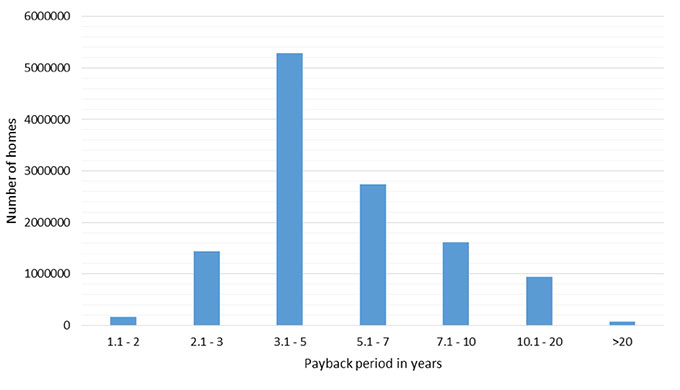Heat pumps are going through a period of innovation including more wide-spread availability of ductless heat pumps, development of cold climate heat pumps, higher minimum efficiency standards for heat pumps, and development of gas-fired heat pumps. Heat pumps are generally fairly efficient as they extract heat from the air, even cold air. A typical new heat pump in the United States is on average roughly twice as efficient as electric resistance heat, although performance varies with climate. While heat pumps can be efficient, they are also more expensive than many types of heating systems, and they generally don’t work well at very cold temperatures.
More than 2% of residential energy use can be saved
In order to examine which applications are good for obtaining cost-effective energy savings from heat pumps, ACEEE conducted a pair of analyses that we are releasing today. One addresses opportunities to replace electric resistance heat with heat pumps and the other addresses replacing gas furnaces with heat pumps. Both analyses use data on actual energy consumption in homes throughout the US collected as part of the Energy Information Administration’s Residential Energy Consumption Survey (RECS). Our analysis of replacing electric resistance heat with heat pumps finds an opportunity to reduce residential sector electricity use nationwide by more than 2%. Additional energy would be saved from using heat pumps instead of gas furnaces in some important applications. Furthermore, multiple analysts (e.g., here and here) see electric heat pumps powered with clean electricity as an important strategy for displacing emissions from in-home combustion of fossil fuels.
For our analysis of converting homes with electric resistance heat to heat pumps, we used data on space heating energy use in a representative sample of nearly 2,000 homes in RECS now using electric resistance heat. This analysis looked at replacing both electric furnaces (which distribute heat via ducts) and electric baseboard heat (heating coils along the baseboard in each room) with heat pumps. Electric furnaces are particularly common in the south but are uncommon in the north. Nearly 90% of homes with electric furnaces already have central air conditioning. We found that installing a new heat pump at the time the existing central air conditioner needs replacement will generally be cost-effective, with the median simple payback period (time for the energy savings to fully pay back the additional cost) being 4.7 years. The distribution of simple payback periods is shown in the figure below. Economics were similar for the 17% of homes with electric baseboard heat that also have central air conditioning. But for homes without central air conditioners, the cost to install a heat pump is higher, and the median simple payback was nearly 15 years, although just over 10% of homes have simple payback periods of five years or less.
For our analysis of replacing gas furnaces with heat pumps, we looked at average space heating energy use of homes with gas furnaces in each of 20 states. We compared the gas used by gas furnaces with the gas used at the power plant to operate a heat pump. For each state, we looked at a variety of furnace, heat pump, and power plant efficiency levels. We also looked at the relative economics for many of the comparisons. We found that electric heat pumps generally use less energy in warm states and have moderately positive economics in these states if a heat pump can replace both the furnace and a central air conditioner. Moderately cold states (as far north as Pennsylvania and Massachusetts) can save energy if electricity comes from the highest-efficiency power plants, but from an economic point of view, life cycle costs for gas furnaces in existing homes will be lower than for heat pumps in these states. (We did not look at new construction where using electric heat and hot water can avoid the need to install gas service.) For cold states (colder than Massachusetts and Pennsylvania), high-efficiency furnaces use less energy than today’s heat pumps, but further development of cold-temperature electric heat pumps and gas-fired heat pumps will be useful from an energy-saving point of view.
Next steps needed to realizing savings
Based on these analyses, we recommend the following next steps:
- State officials and utilities should conduct further analysis at the state, local, and utility levels. More nuanced analysis at the utility or local level, based on specific rate schedules and climate zones, will more clearly indicate who might benefit from heat pumps and who will not.
- Manufacturers and R&D organizations should continue work to develop good cold-climate electric air-source heat pumps and gas-fired heat pumps.
- Energy efficiency program administrators should consider programs to encourage use of heat pumps in warm states, starting with further localized analysis and proceeding to pilot programs.
More localized analysis is needed, but our analyses find likely opportunities to save energy and money and reduce emissions by using electric heat pumps, particularly in warm states.




